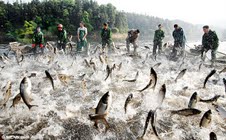A Carp by Any Other Name Would Taste So Delicious
Asian carp, originally brought to America in the 1970s to clean ponds, has since escaped to major waterways, reproduced at lightening speed, and has now become an invasive species. Able to grow up to 100 pounds, these carp eat so much that they threaten other species of fish and disturb the balance of ecosystems. They also like jumping out of the water while swimming and have the unfortunately powerful ability to damage boats and fishing equipment. Managing this ever-expanding population of Asian carp has proven to be tricky, as none of the projects – including poison, electric barriers, management committees, and even the White House naming an Asian carp czar – have been able to slow down their growth. Recently, some creative chefs and wildlife agencies have developed what looks to be a promising solution: promoting people to eat the carp.
to damage boats and fishing equipment. Managing this ever-expanding population of Asian carp has proven to be tricky, as none of the projects – including poison, electric barriers, management committees, and even the White House naming an Asian carp czar – have been able to slow down their growth. Recently, some creative chefs and wildlife agencies have developed what looks to be a promising solution: promoting people to eat the carp.
While this approach may sound new-fangled and ingenious, it is actually not such a new solution. Promoting the consumption of invasive, problematic, or overabundant fish has been done a handful of times in the past. The normal person is simply unaware this promotion is being done, for secrecy is all part of the marketing strategy. After all, have you ever heard of Patagonian Toothfish? No? I’m sure you’ve at least heard of the coveted, and very expensive Chilean Sea Bass. Well, the truth is that Patagonian Toothfish and Chilean Sea Bass are the same fish! Years ago, the Patagonian Toothfish was renamed to sound more appetizing in order to get more people to eat it. What’s ironic is that this fish that was once overly abundant (and the entire reason it was renamed and promoted), is currently in danger of being overfished, with environmental groups advocating that consumers avoid eating it. However, this problem of fish being endangered due to overfishing and high demand is a completely different issue; the point is that this renaming of fish has already been applied to numerous species, so why not also rename Asian carp? This would be a smart and influential move to rename the carp and start a PR campaign for it. Asian carp is usually not incorporated into diets because it has a stigma to it. People associate these fish as muddy bottom-feeders. For such a dirty looking fish, the majority of the public tends to assume carp won’t taste good.
As a freshwater fish that is taking over the Great Lakes and Mississippi River, most chefs in the areas surrounding these waterways have jumped at the chance to help eradicate the overpopulation of Asian carp. Ambitious chefs have already begun serving Asian carp with a new moniker. Some have paid homage to its Asian origins by dubbing it Shanghai Bass in their restaurants, and Louisiana has even gone so far as to create an official Silverfin Promotion Campaign. Carp dishes in these restaurants have already become wildly popular with chefs, critics, and consumers all pleasantly surprised by how tasty Asian carp is.
Renaming and promoting the edibility of this fish is a great method that’s sustainable. We’ll be safely and easily solving a problem of an invasive species, because we won’t be resorting to poison that’s not only unsafe to other fish, but to people who are eating fish. This approach is also inexpensive in comparison to the multi-million dollar project that erected electric barriers to prevent more carp from further invading the Great Lakes. Since past experiences have proven that it’s impossible to fully eradicate the Asian carp population, we should then turn to the alternative solution of creating demand for what Asian carp can offer. Now that the cat’s out of the bag (or I guess I should say “the fish is out of the net?”) on the tastiness of Asian carp, it remains to be seen whether it’ll will be more widely introduced and accepted as a part of our meals. If you’re interested in more information on what types of fish to eat or avoid in a bid to be environmentally conscious, please check out these handy safe seafood lists!


